


Annex 5.1 History and Future of MCS
Slide 1
|
History and Future of Monitoring Control and Surveillance
Andrew R Smith
Fisheries Industries Officer
FAO, Rome
|
Slide 2
|
Summary
History of
Fisheries Policing The Law of the Sea and how it
changed the Rules of the Game Changes in the World’s
Fleets The Emergence of VMS The Effectiveness of the Tools
of MCS Satellite
Surveillance VMS in Fisheries
Management
|
Slide 3
|
ORIGINAL NATIONAL LIMITS
Up until 1982,
most territorial sea limits were 3 nautical miles to 12 nautical miles
Therefore States could only
control the activities of their own vessels outside these limits
This was reflected in the name
given to the policing activity (In the UK “Fisheries
Protection”)
|
Slide 4
|
ORIGINAL LIMITS (cont)
These restricted
limits allowed visual location of vessels from the shore.
Many countries entered into
Multilateral Agreements to “manage” fisheries (i.e. Minimum mesh
sizes, minimum landing sizes in the North Sea etc)
Never limited the amount of
fish landed
Led to the moratorium on the
herring fishery in the North Sea in 1980
|
Slide 5
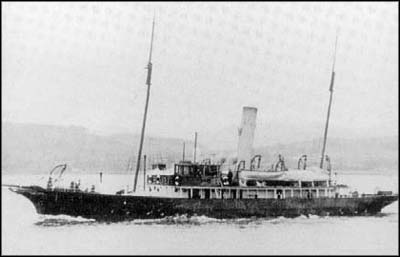
Slide 6
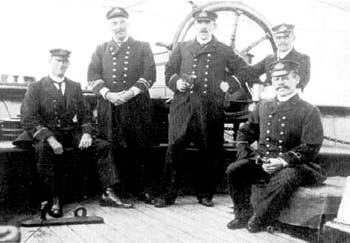
Slide 7
|
The Law of the Sea
Three Conferences
led to the formulation of the Law of the Sea Convention in 1982 (LOSC)
Exclusive Economic Zones
established at 200 nautical Miles.(not only for fisheries but for mineral
rights)
However many countries have
not declared EEZs (i.e. Mediterranean, Yellow Sea, Caspian
Sea)
|
Slide 8
|
Exclusive Economic Zones
EEZs extended the
areas of some fisheries jurisdictions hundred fold and in particular created a
new requirement in developing countries.
Greatest increases in area
were off Small Islands such as in the South Pacific and led to the development
of the South Pacific Fisheries Forum Agency (includes Australia and New
Zealand)
|
Slide 9
|
Monitoring Control and Surveillance (MCS)
In 1982 FAO held
an Expert Consultation on Monitoring Control and Surveillance
The definition of MCS was
given as follows
Monitoring - the continuous
requirement for the measurement of fishing effort characteristics and resource
yields.
|
Slide 10
|
Monitoring Control and Surveillance (MCS)
cont
Control - the
regulatory conditions under which the exploitation of the resource may be
conducted
Surveillance - the degree and
types of observations required to maintain compliance with the regulatory
controls imposed on fishing activities.
Broad
Definition
|
Slide 11
|
Development of MCS
Some developed
countries already had the capacity with a Navy for military duties and
Coastguard for civil duties.
Many countries rely on their
Navy for the implementation of MCS
However since the end of the
Cold War funding of military vessels has been reduced drastically and some are
even limited by the cost of fuel
|
Slide 12
|
Development of MCS (cont)
Many countries who
had established large EEZs found that the obligations probably exceeded the
opportunities gained.
The adjustments that were
expected in the fleets, with a decrease in the fleets of Distant Water Fishing
Nations (DWFNs) and an increase of the fleets in developing countries has been
very slow.
|
Slide 13
Global Fleet of Large Fishing
Vessels
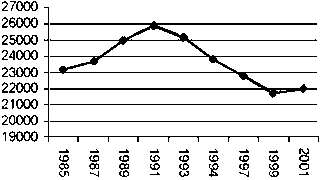
Slide 14
Increase in the Fleets of
Developing Countries of Africa
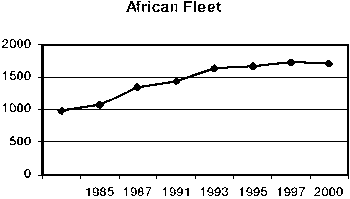
Slide 15
Trends In the Major Fishing
Fleets
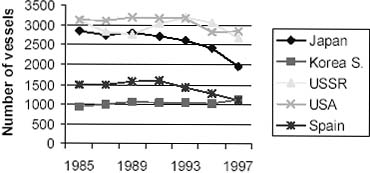
Slide 16
Latin American Countries

Slide 17
Trends in the European
Fleet
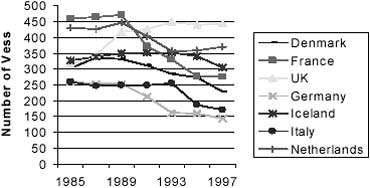
Slide 18
Flags of Convenience
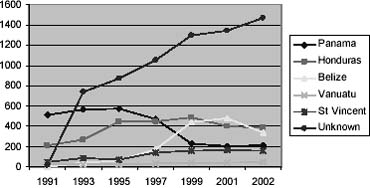
Slide 19
Changes in the catches of Distant
Water Fishing Vessels
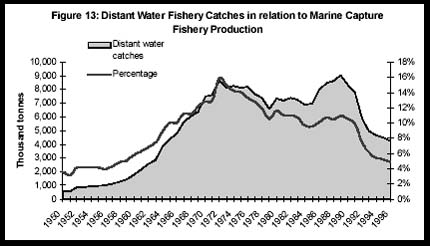
Slide 20
|
Code of Conduct for Responsible Fisheries
In the early 1990s
it was realised that there were major problems in fisheries
High Seas Fisheries were
totally unregulated
Call for a Code of Conduct for
Responsible Fisheries with a Reflagging Agreement to be put on the fast
track
FAO High Seas Compliance
Agreement (1993)
Code of Conduct agreed
(1995)
|
Slide 21
|
International Plans of Action
Reducing
Incidental Catch of Seabirds in Longline Fisheries
The conservation and
Management of Sharks.
The Management of Fishing
Capacity
On Combating Illegal
Unreported and Unregulated Fishing (IUU Fishing)
|
Slide 22
|
Emergence of VMS
First use of VMS
was for USA to track Korean vessels
Australia and New Zealand
start to monitor Japanese longliners and eventually their own trawlers
Portugal starts tracking
vessels as pilot study for European Union
Now all vessels over 20 metres
have to report by VMS (6,000 vessels)
|
Slide 23
|
Emergence of VMS (Cont)
USA slow to adopt
blanket coverage such as EU and other countries because of legal
issues
Most countries with
significant fishing interests have already adopted VMS for at least part of
their fishing fleets.
|
Slide 24
FAO Statistical Areas
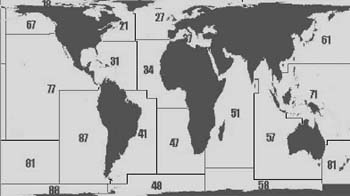
Slide 25
|
What VMS can do
Monitor vessels so
that they do not enter closed areas.
Monitor vessels so that
inspections can be targeted. (i.e. patrol vessel does not need to
search)
Gives warning of when a vessel
is going to land.
Gives an indication of the
activities of a vessel.
Allow a country to exercise
“control” over its fishing vessels wherever they are as required by
International Agreements.
|
Slide 26
|
VMS seen within the overall context of MCS
VMS cannot arrest
a vessel Cannot measure mesh
size Cannot examine
documents Cannot monitor an unauthorised
vessel Cannot monitor
transhipments Hence - VMS is just one tool
in the MCS toolbox.
|
Slide 27

Slide 28

Slide 29
|
Looking to the Future
Satellite
Surveillance by SLAR Comparison with VMS
data Satellite Surveillance by in
Visual Spectrum Interdiction by Surface
Vessel If Necessary. Arrest and
escort to port
|
Slide 30
|
Changes caused to MCS by VMS and Satellite
Surveillance
MCS will become
more cost-effective. Increase in cost-effectiveness
will reduce costs or increase effectiveness. Increases in effectiveness
will be difficult to measure. Synergies of MCS components
will have to be reviewed continually. Property rights will impinge
on decisions and on “Who pays?” - “Who
says!”.
|
Slide 31
|
APPENDIX I
EFFECTIVENESS OF DIFFERENT TYPES OF VESSEL MONITORING
|
|
Type of MCS
|
Description of Monitoring
|
No of Vessels Inspected
|
Effectiveness of Monitoring of
|
Amount of Time Observed
|
Effectiveness of Detection of Unlicensed Vessels
|
Coverage at Sea
|
Cost (US$)
|
Power of Arrest
|
|
Position
|
Fishing Gear
|
Catch Quotas
|
Days at Sea
|
|
By Vessel
|
Identification by sight and boarding for Inspection
|
12/day
|
High
|
High
|
Medium
|
Low
|
Low
|
High
|
300 sq. miles per hr
|
500-140,000 per day
|
Yes
|
|
By Air
|
Limited to daylight and identification
|
60/day
|
High
|
Low
|
None
|
None
|
Low
|
High
|
3000 sq. miles per hr
|
$400-3000 per hr
|
No
|
|
Shore Based
|
Inspection of catch and fishing gear. Coastal Surveillance
|
15/day
|
None
|
High
|
High
|
High
|
|
Low
|
None
|
$150/day
|
Yes
|
|
Observers on Vessels
|
Continual observation of activities
|
1
|
High
|
High
|
High
|
High
|
High
|
Medium
|
High
|
$200/day
|
No
|
|
Vessel Monitoring System
|
Periodic Monitoring of Vessels Position
|
All Vessels Fitted
|
High
|
None
|
None
|
High
|
High
|
None
|
Complete for Vessels Fitted
|
$100,000+$8,000/vessel
|
No
|
Slide 32
|
APPENDIX II
MCS RECOMMENDATIONS AND COSTS FOR VARIOUS TYPES OF
FISHING FLEET
|
|
Type of Fishery
|
Type of MCS Recommended
|
Amount of MCS Recommended
|
Capital Cost US$
|
Running Costs/vessel monitored/day
|
|
Artisanal Fleet (vessels < 12m)
|
Shore based
|
1 Fishery Officer per 100 boats
|
None
|
2
|
|
By vessel
|
1 Small Patrol Boat (4 crew)/500 boats
|
500,000
|
2
|
|
Domestic Industrial Fleet (12m<vessels<24m)
|
Shore based
|
1 Fishery Officer per 40 vessels
|
None
|
5
|
|
By Vessel
|
1 Medium Patrol Boat (10 crew)/500 boats
|
2 million
|
6
|
|
By Air
|
1 small aircraft/1000 vessels
|
1 million
|
5
|
|
Large Domestic Vessels (Vessels >24m)
|
Shore Based
|
1 Fishery Officer/20 vessels
|
None
|
10
|
|
By Vessel
|
1 Large Patrol Vessel (30 crew)/100 vessels
|
10 million
|
20
|
|
By Air
|
1 Medium Aircraft/500 vessels
|
10 million
|
25
|
|
Observer
|
2 Observers per Vessel (if necessary)
|
None
|
400
|
|
VMS
|
Recommended for all fleets >50 vessels
|
100,000
|
20
|
|
Foreign Fleet
|
Shore Based
|
1 FO/10 Vessels for Port State Control
|
None
|
20
|
|
By vessel
|
1 Large Patrol Vessel (30 crew)/50 vessels
|
10 million
|
40
|
|
By Air
|
1 medium aircraft/100 vessels
|
10 million
|
25
|
|
Observer
|
2 Observers per vessel
|
None
|
400
|
|
VMS
|
Recommended for all fleets >20 vessels
|
100,000
|
20
|
Slide 33
|
HYPOTHETICAL ESTIMATION OF MCS REQUIREMENT (From APPENDIX
II) |
|
No and Category of vessels |
Fishery1 Officers |
Vessels |
Aircraft |
Observers |
VMS |
|
2,000 Artisanal |
20 |
4 inshore |
|
|
|
|
500 Medium Domestic |
15 |
1 medium |
1 Small |
|
|
|
200 Large Domestic |
10 |
2 Large |
1 medium |
400 (if necessary2) |
Recommended |
|
50 Foreign Vessels |
5 |
|
|
100 |
Recommended |
|
Capital Cost |
|
Running Costs |
|
|
4 Inshore Vessels |
2 million |
|
|
|
1 Medium Vessel |
2 million |
100 Fishery Officers |
7 million |
|
2 Large Vessels |
20 million |
4 Inshore Vessels |
1 million |
|
1 Small Aircraft |
1 million |
1 Medium Vessel |
1 million |
|
1 Medium aircraft |
10 million |
2 Large Vessels |
20 million |
|
1 VMS |
0.1 million |
2 Aircraft |
6 million |
|
Total |
35 million |
Total |
35 million. |
1 This is only for inspection and the
total establishment for data collection, administration should be
doubled
2 Observers should only be considered for domestic
vessels if considered necessary for environmental reasons or in cases where
there is a high probability of non-complance
Slide 34
|
APPENDIX IV ADVANTAGES AND DISADVANTAGES OF THE VARIOUS MCS
SYSTEMS |
|
Type of MCS |
ADVANTAGES |
DISADVANTAGES |
|
By Vessel |
Provides at sea verification that fishing gear and catch is
legal. Most important to control Transhipment and arrest particularly of foreign
vessels |
Very costly |
|
By Air |
Can provide the best coverage for identification of illegal
incursion of unlicensed vessels and also of observation of boxes |
Very costly. No ability t5o arrest. No ability to inspect the
catch or fishing gear. |
|
Shore based |
Lowest running costs and low capital costs. Can monitor landed
catch and quotas. Only power of arrest in port. |
No possibility of monitoring foreign vessels that do not call
at port. No possibility of monitoring transhipment |
|
Observers |
Can observe all operations |
High cost. Only viable on larger vessels. |
|
Vessel Monitoring System |
Provides almost real time monitoring of position for fitted
vessels and can reduce interception times for enforcement craft. Relatively low
capital cost and running costs borne by fishing vessel |
No coverage for vessels not fitted with the system. Involves
cost of 10,000 for the fishing vessel. No detection of unlicensed
vessels. |
Slide 35
Fisheries co-management
typologies
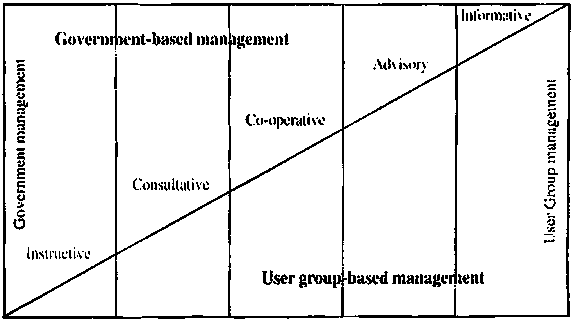
Slide 36
Pilbara Trawl Fishery
Area
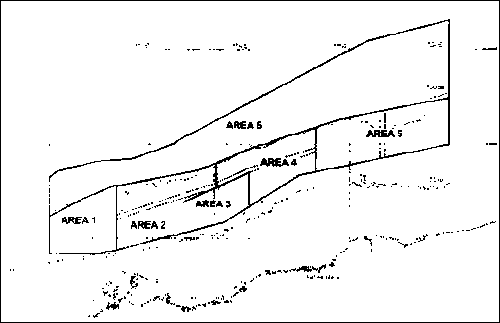
Slide 37
|
Use of VMS as a tool for Fisheries Management
(PilbaraTrawl Fishery)
Problem of
Multi-species Trawl Fisheries
Mesh sizes and minimum landing
sizes based on size of species at maturity. Hence cod-end mesh size is a
compromise
Problem occurs because larger
sized fish are overfishedsmaller fish are underfished
However if the distribution of
fish species are slightly different, the amount of fishing can be regulated in
each zone to obtain an optimal harvest from each of the
species
|
Slide 38
|
USE of VMS as a tool for Fisheries management
(cont)
Clearwater scallop
fishery in Canada
The Company has a monopoly on
the scallop fishery
It can collect data on the
size and abundance of scallop from the different sectors.
The company can then decide on
the optimal strategy for optimisation of the harvest.
|
Slide 39
|
Use of VMS as a tool for Fisheries management
(cont)
Gulf of
Carpentaria Prawn Fishery
Shrimp grow rapidly after the
floods washing them out of the juvenile areas into salt water.
Fishing too early results in
small shrimp
Fishing too late and the
shrimp are dispersed with low catches
|
Slide 40
|
Use of VMS as a tool for Fisheries management
(cont)
Research vessels
cannot cover the entire area
Fishing fleet is allowed to
start fishing, but report by VMS the size of shrimp caught.
If the size of shrimp is OK
the the fleet carries on fishing. If shrimp are too small then the opening of
the fishery is postponed.
|
Annex 5.2 The International Plan of Action on IUU
Fishing
Slide 1
|
The International Plan of Action on IUU Fishing
Andrew R Smith
Fisheries Industries Officer
FAO, Rome
|
Slide 2
|
Background
The term IUU
Fishing first used by the Commission for the Conservation of the Antarctic
Living Marine Resources (CCAMLR)
It is believed that IUU
Fishing is increasing
In 1999 the FAO Committee on
Fisheries (COFI) recommended the elaboration of an International Plan of
Action
|
Slide 3
|
Background (cont)
This was backed by
the FAO Ministerial meeting on Fisheries in March 1999
Expert Consultation held in
Australia in May 2000
Technical Consultation held in
Rome Oct 2000
Finally adodted by COFI in
March 2001 and FAO Council subsequently
|
Slide 4
|
Definitions of IUU Fishing
- Illegal Fishing refers to fishing activities
- Conducted by national or foreign vessels in waters under the
jurisdiction of a State, without the permission of that State, or
in contravention of its laws and regulations
- Conducted by vessels flying the flag of States that are party
to a relevant regional fisheries management organisation but operate
in contravention of the conservation and management measures adopted
by that organisation and by which the States are bound, or relevant
provisions of the applicable international law: or
- In violation of national laws or international obligations, including
those undertaken by cooperating States to a relevant regional fisheries
management organisation.
|
Slide 5
|
Definitions of IUU Fishing
- Unreported fi0shing refers to fishing activities
- Which have not been reported, or have been misreported, to the
relevant national authority, in contravention of national laws and
regulations;or
- Undertaken in the area of competence of a relevant regional fisheries
management organisationwhich have not been reported or have been
misreported, in contravention of the reporting procedures of that
organisation.
|
Slide 6
|
Definitions of IUU Fishing
- Unregulated fishing refers to fishing activities
- In the area of application of a relevant regional fisheries management
organisation that are conducted by vessels without nationality,
or by those flying the flag of a State not party to that organisation,
or by a fishing entity, in a manner that is not consistent with
or contravenes the conservation and management measures of that
organisation; or
- In areas or for fish stocks in relation to which there are no
applicable conservation or management measures and where such fishing
activities are conducted in a manner inconsistent with State responsibilities
for the conservation of living marine resources under international
law.
|
Slide 7
|
IUU Fishing and MCS
IUU Fishing is the
problem MCS is one of the answers to
the problem MCS has a very wide definition
but tends to concentrate of the “Policing” of fisheries at
sea
|
Slide 8
|
All States Responsibilities
|
Slide 9
|
Flag State Responsibilities
Flag State has
exclusive jurisdiction when the vessel is fishing in the flag State waters
(subject to bilateral agreements)
On the high seas, again the
Flag State has exclusive jurisdiction (subject to international
agreements)
In the waters of another
State, that State has the right or obligation to manage the fisheries and
regulate the fishing activities of the vessel but the flag State still retains
jurisdiction over the vessel.
|
Slide 10
|
Flag State Responsibilities (cont)
- Registration
- Registration of a vessel is the means whereby the vessel acquires
nationality and the right to fly the States flag
- However the “Register” is also a register of property
containing the names of owners, shares and also details of mortgages
or liens.
- Usually this is the responsibility of the maritime administration.
|
Slide 11
|
Flag State Responsibilities (cont)
Record of Fishing
Vessels Authorisations to Fish
(including authorisations to fish on the high seas) Control over transport and
support vessels
|
Slide 12
Slide 13
|
Port State Measures
Port State Control
has been in existence for many years for merchant ships (Environment, Safety and
Working Conditions - IMO and ILO)
Port State Measures is
a new concept for fisheries management and is just being developed.
Two weeks time an Expert
Consultation will be held in Rome (the background document for the meeting has
been provided)
|
Slide 14
|
Internationally Agreed Market Related
Measures
Trade Documents
were introduced by ICCAT in 1994 and 1995
Originally called Statistical
Document, the original purpose was to check the amount of bluefin tuna being
imported into Japan and Europe
It was found that 30% of the
catch of bluefin tuna was not being reported.
|
Slide 15
|
Internationally Agreed Market Related Measures
(cont)
The Trade Document
was then used to implement a ban on bluefin tuna imported by ICCAT countries
from Panama, Honduras, Belize and St. Vincent.
These countries subsequently
joined ICCAT and took measures to control their vessels
The scheme now includes
swordfish and big-eye tuna
Similar schemes have been
adopted by IOTC, CCSBT and CCAMLR.
|
Slide 16
|
Internationally Agreed Market Related Measures
(cont)
These measures
were the most contentious of all the measures in the IPOA, because they related
to WTO and CITES.
WTO has now given the opinion
that Trade Documentation is a good example of environment measure undertaken by
a multilateral agreement.
Trade in fish products now
accounts for $51 billion, of which developing countries receive $17
billion.
|
Slide 17
Changes caused by ICCAT
Measures
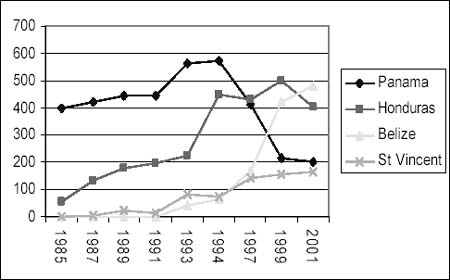
Slide 18
|
Role of RFMOs
Meetings of
Regional Fisheries Management Organisations now held before and after COFI
(every two years)
Some of the RFMOs have been
very effective in the fight against “flags of convenience” and IUU
Fishing (i.e. ICCAT, IOTC, CCAMLR, I-ATTC, FFA, CCSBT)
Databases of vessels,
Inspection and enforcement, port and transhipment inspections, trade measures
and cooperation with nonmembers.
|
Slide 19
|
Possibilities for Further Action
Institutional
Strengthening Additional Compliance
Measures Better Collection and Exchange
of Information Improved Monitoring and
Surveillance Comprehensive Port
Regimes
|
Slide 20
|
Possibilities for Further Action (cont)
Certification and
Documentation Schemes Controls on
Chartering Actions in Response to
remaining NonMember Countries Cooperation among RFMOs and
other International Organizations Finally - National Plans of
Action
|
Annex 5.3 MCS and IUU in the SRFC Areas
Slide 1
|
MCS and IUU in the SRFC area
Kieran Kelleher
Sub-Regional VMS Workshop
Saly, Sénégal, 14-17 October, 2002
|
Slide 2
|
Content of the Presentation
1. Overview of MCS, IUU and related fisheries management issues:
- the FAO/LUX/012 study on MCS in the sub-region
- the AFD/DPSP study on MCS in Senegal undertaken by Oceanic Developpement
- UCOS (SOCU) databases
2. What is the place of VMS in a national, or sub-regional suite of
MCS activities?
|
Slide 3
|
MCS/IUU overview
1. MCS institutions
2. Fishing fleets in the sub-region
3. Fishing activities and key fisheries management measures
4. IUU in the sub-region
5. Key enforcement issues
|
Slide 4
|
MCS institutions
Civil authority
(DPSP, DSPCM, Fisheries Ministry or Department) Defence forces (Guarda
Costeira, Navy Wing) SAR, Merchant Marine,
Port/navigation authorities Communications (Ministry of
Telecommunications) Fishermen’s
organisations/associations UCOS/SOCU and SRFC
conventions
|
Slide 5
|
Sub-Regional Fleets
- Industrial fleets (approx. 1570 vessels)
- National - mainly trawlers
- Foreign licenced and high seas (trawlers, tuna vessels)
- Flags of Convenience (FOCs)
- Unlicensed/‘pirate’
- Artisanal (approx. 35,000 pirogues/canoes)
- Increasing
- National and international fishing activities
- Safety
|
Slide 6
|
Industrial fleet by flag
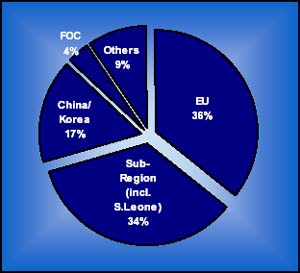
|
|
Breakdown of industrial fleet licensed in one, or more
(excluding Cape Verde, source UCOS database) |
|
Number of countries in which vessel is fishing |
4 |
3 |
|
Number of vessels |
22 |
33 |
Slide 7
|
Industrial fleet by type of fishing
· Approximately 80% trawling
(example): |
|
Breakdown of Mauritanian licensed fleet (2000) by type
of |
|
Demersal (mainly trawlers) |
245 |
61% |
|
Pelagic (mainly trawlers) |
83 |
21% |
|
Tuna (seiners, liners) |
73 |
18% |
|
Source: DSPCM |
|
|
|
· Almost all tuna fishing
vessels are non-SRFC flag |
Slide 8
|
Fishing activities
- Industrial trawling
- Targetteddemersal (shrimp, cephalopods)
- Un-targetteddemersal (finfish)
- Pelagic (mainly foreign/chartered)
- Measures: licensing, zoning, mesh
- Tuna and HMS
- mostly foreign/licensing & zoning
- Artisanal
- conflicts with industrials/transboundary operations/safety at sea
|
Slide 9
|
IUU in the SRFC area
Most common and
important violations by industrial vessels Specific examples from
countries Possible role for VMS in
combatting violations
|
Slide 10
|
Violations (industrial fisheries)
Reported vs total
violations Vessel
characteristics Zones, or closed areas }
60-80% of violations Trawl mesh } 60-80% of
violations Catch reporting } 60-80% of
violations ‘Pirate’ or
unlicensed fishing
|
Slide 11
|
Vessel characteristics 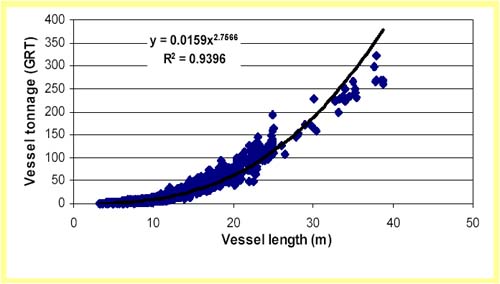
Tonnage (GRT)/length (m) relationship for French
fleet |
Slide 12
Vessel characteristics -
2
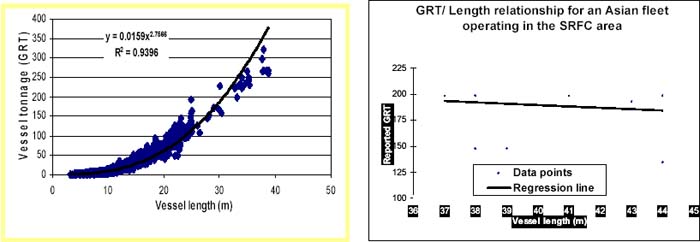
Slide 13
|
Zone violations
- Zones are essential for protection of:
- artisanal fishing grounds
- juveniles and
- conservation areas
- Up to 20% of detected violations are zone violations (CV, GA, GU,
SL)
- Most frequent non-administrative violation in Mauritania (1988-2002)
- 51% of violations (PVs) in Senegal
- Conclusion: Zone regulations very poorly enforced
|
Slide 14
|
Can VMS help enforce zone controls?
- Electronic definition of zones
- Violation definition
- Entry to the closed zone, or
- Fishing in the closed zone
- Legal nature of the zone offence
- civil, or
- criminal
- presumption and burden of proof
|
Slide 15
Seasonal changes in zones
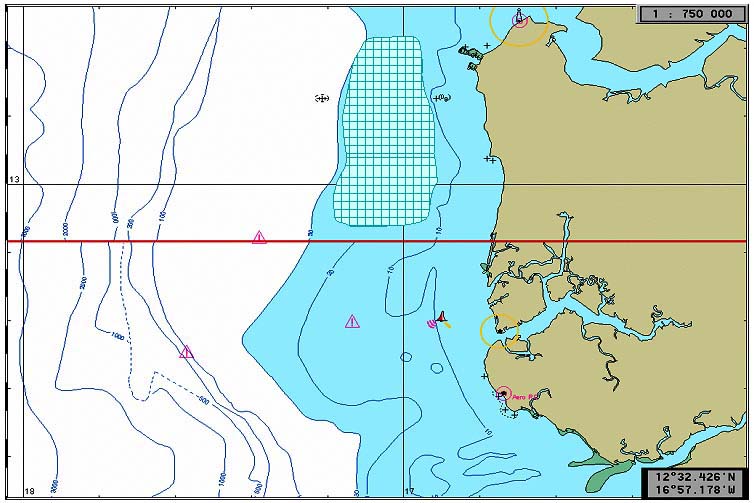
Slide 16
|
Mesh, gear and by-catch violations
Mesh: second most
frequent type of violation in Senegal (23% of total PVs) 92% of vessels in Guinea
(observers) Shrimp vs finfish
mesh VMS: near real time catch
reporting
|
Slide 17
|
Catch reporting
EU: 15-25%
mis-reporting in certain fisheries ICES stock assessments
dependent on catch information Near real time catch
reports/secure electronic logs Combined with at-sea and port
checks
|
Slide 18
|
‘Pirate’ (unlicensed) fishing
- Detection level ?
- Role of VMS
- Incursions by known vessels
- licence conditions
- International initiative
Longliner detected fishing illegally 130nm off Freetown
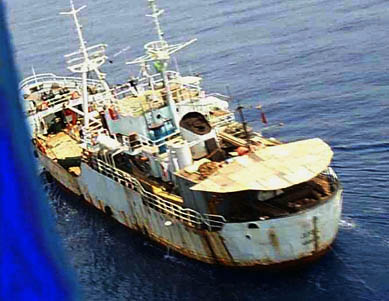
|
Slide 19
|
Selected institutional issues
|
Slide 20
|
Selected operational issues
A focus on the
licensed industrial vessels Vessels operating under
fishing agreements Effective enforcement of
fishing zones Solutions for monitoring and
safety of artisanal vessels In the longer term - use of
VMS for effort control
|
Slide 21
|
In summary:
- VMS
- is part of a suite of MCS activities,
- guided by and
- serving and enforcing a fishery management plan
- National priorities and constraints
- Sub-regional - bilateral and subregional initiatives - prerequisites
- Regional and global initiatives
|
Annex 5.4 Fishing Vessel Monitoring: The What, Why and
How
Slide 1
|
Fishing vessel monitoring
The what, why and how
Robert Gallaher,
FAO Consultant
|
Slide 2
|
What is VMS?
The use of
communications and navigation systems to track the movements of
vessels A tool for improving the
efficiency of MCS A tool for improving the
effectiveness of resource management
|
Slide 3
|
What does VMS require?
Transmission
equipment aboard vessels A transmission
medium/system A means of receiving, storing,
displaying and manipulating data
|
Slide 4
|
Shipboard equipment
Typically a
standard, satellite transmitter or transceiver Almost always integrates
global positioning system (GPS) receiver Can be part of vessel’s
communications system or completely independent
|
Slide 5
|
Transmission medium
- Two essential elements:
- From ship to shore
- From shore to fisheries monitoring centre (FMC)
- Until present, satellites have exclusivity for ship to shore, but
others possible
- Shore to FMC can be data connection (X.25, internet), telephone (fixed
or cellular) or satellite relay.
|
Slide 6
|
FMC: data storage & processing
Typically
standard, PC hardware Communications module assures
interface with transmission medium Data base manager stores and
manipulates data Graphics program permits
display of data on maps
|
Slide 7
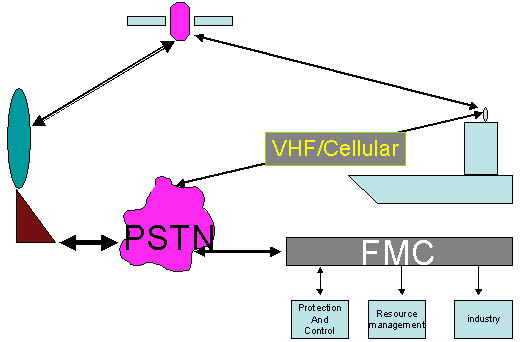
Slide 8
|
Basic operational scenario
- Equipment aboard vessel creates data file at pre-determined intervals
- File contains position of vessel in latitude and longitude
- Perhaps speed and course
- File is transmitted via transmission media to FMC
- FMC puts data at disposal of authorities for use and possible distribution
|
Slide 9
|
What does data provide?
At very minimum,
an historical record of vessel’s movements Depending upon configuration
used, a quasi-real-time view of vessel behavior The basis for deductions as to
fishing and commercial activity
|
Slide 10
|
A word about security
This data is
highly confidential for good reason Sufficient measures must be
taken to guard that confidentiality Failure to do this could well
lead to compromise, or even failure, of project More later
|
Slide 11
|
Analyzing VMS data -- 1
- The most basic case: latitude, longitude plus time stamp
- Estimation of fishing effort measured in days at sea
- Determination of ports for landing
- Control of passage or fishing activity in restricted areas
|
Slide 12
|
Analysing VMS data -- 2
- Addition of speed and course
- Determination of “probable” fishing activity using
speed
- Certain determination of fishing activity using “fishing
fingerprint”
- Prediction of future activity of vessel
|
Slide 13
|
Putting VMS data to use -- 1
- Fisheries protection & control
- Control of fishing effort
- Control of protected/forbidden zones
- Control of illegal landings
- Control of illegal trans-shipments
|
Slide 14
|
Putting VMS data to use -- 2
- Fisheries protection & control --2
- Increasing the efficiency of patrol vessels and aircraft
- Providing a credible deterrent to illegal fishing
- Providing supporting evidence in prosecutions
- A powerful tool against illegal fishing
|
Slide 15
|
Putting VMS data to use -- 3
- Resource management
- Calculation of fishing effort
- In zone as a whole
- In specific areas
- In specific fisheries
- Follow evolution of fishing grounds
|
Slide 16
|
Putting VMS data to use -- 4
- Cross-referenced with landing and research data
Analysis of
fisheries under pressure of over-exploitation Analysis of seasonal trends in
fisheries Preventive measures in
allocation of fishing effort and quotas
|
Slide 17
|
Putting VMS data to use -- 5
- At the service of industry
- Opportunity to share data to make resource management a communal
effort
- Distribute data in real-time to assist operations
- A serious deterrent to illegal fishing
- Significantly improved safety at sea
|
Slide 18
|
Future developments -- 1
Predicted plethora
of new satellite systems unlikely to develop Nonetheless, equipment and
services of existing providers tending lower The range of companies
providing FMC software and related services is growing
quickly
|
Slide 19
|
Future developments -- 2
- Electronic log book
- Missing link in data necessary for most effective control and
management
- Most important impediment is lack of standard data format
- Earth observation satellites to provide independent verification
of VMS data
- Definitive tool against illegal fishing
|
Annex 5.5 Institutional Options for VMS
Slide 1
|
Institutional options for VMS
Kieran Kelleher
Sub-Regional VMS Workshop
Saly, Sénégal 14-17 October, 2002
|
Slide 2
|
Presentation
Uses of VMS in
fisheries control Criteria for selection of
fisheries National VMS schemes International VMS
schemes
|
Slide 3
Slide 4
Slide 5
|
Criteria for selection of fisheries
Health of the
fishery, or habitat Low compliance
levels High enforcement
costs Number/size of vessels
involved Geographical distribution of
fishery Need for ‘immediate’
information Need more accurate management
data Views of the fishing
industry Safety of
vessels
|
Slide 6
|
Examples of VMS schemes
National
- Ireland
- Norway
- France
- Mozambique
- USA
International
- FFA
- CFP
- Other RFOs
|
Slide 7
|
Ireland
Fisheries
Monitoring Centre (FMC) and VMS
- operated by Navy
- nightly downloads to vessels + updates as required
- aerial surveillance info faxed and emailed to FMC
Networked to fisheries
administration
State of the art
‘intelligence’, or ‘expert’ system
- vessel histories including all sightings
- targeting more frequent offenders
- software link to ‘intelligent legal checklist’ and
- decision framework for on-board inspector
|
Slide 8
Slide 9
|
France - 2
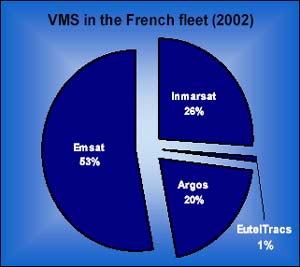
CROSS (Etel)
FMC investment
€366,000 Recurrent costs €90,000
per year for transmissions
- » 900
vessels (» 500 French)
+ 7-8 operations personnel (24
hr) + maintenance personnel (in
house) 5% of vessel VMS
‘down’ - fax, radio
|
Slide 10
Slide 11
Foreign and Norwegian vessels today
- Norwegian zones
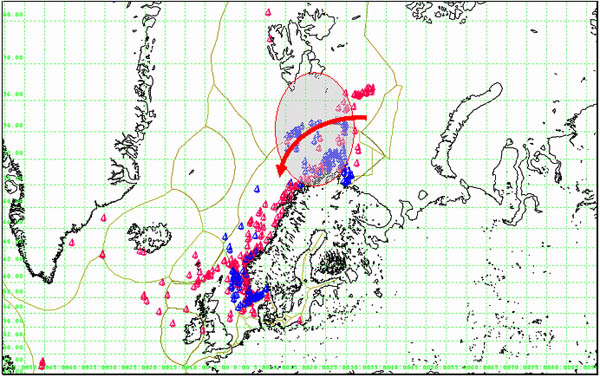
Slide 12
|
Norway
Operated by
Directorate of Fisheries
- operational arm of the Ministry of Fisheries
- 9 regional offices
Networked to Coast
Guard
- 3 regional divisions, military + civil
- own + chartered vessels and aircraft
- checkpoints
Interface with/compatible with
EU
Exchange of information with
EU and RFOs
- i.e., EU vessels in Norwegian waters
and Norwegian vessels in EU waters - Also with NAFO and NEAFC (USA, Canada, Russia,
etc.)
|
Slide 13
Norwegian VMS
organization
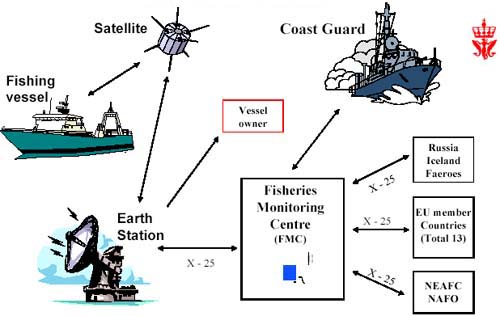
Slide 14
Tracks of Norwegian blue whiting
trawlers transiting UK and Irish waters

Slide 15
|
Barents Sea active closures - 1
Juvenile cod
by-catch in Bering Sea shrimp fishery
Constant monitoring of
by-catch by
- 14 chartered trawlers
- research surveys
- observers
Decision rule > 15%
by-catch of juvenile cod
- close large blocks
Open by smaller block when
juvenile cod by-catch < 15%
|
Slide 16
Barents Sea active closures -
2
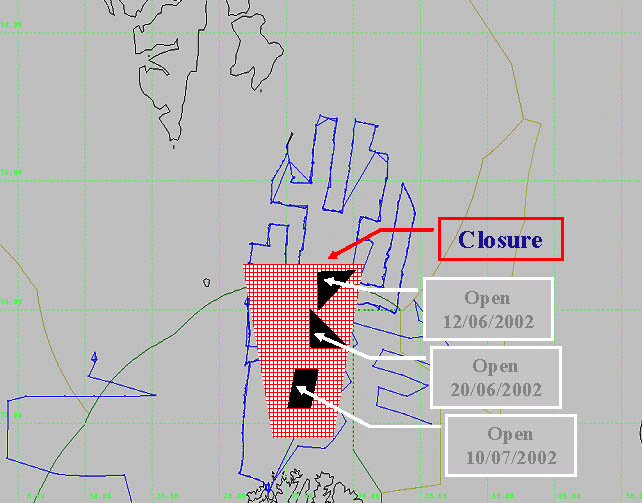
Slide 17
Slide 18
Slide 19
Slide 20
|
Hawaiian longline closed area
- Patrol costs pre-VMS
- vessels 3000 hours/$1000 per hour = $3 million
- Air 350 hrs/$7,500 per hour = $2.6 million
- Total per year (120 vessels) = $5.6 million
- Patrol costs post-VMS
- Vessels 110 hrs/$1000/hr = $110,000
- Air 8 hrs/7,500/hr = $60,000
- VMS operations = $200,000
- Total per year = $370,000
- Annual theoretical benefit $5.2 million
|
Slide 21
|
USA Gulf of Maine: days-at-sea
Scallop fishery
effort + closed area (zone)
- same vessel operates in several fisheries
- -300m accuracy, 250 vessels
- allowed only “X” days fishing scallop in a given area
Days-at-sea
- Clock starts upon entry to zone - 2 hour units
- Presumption
- Other fishery-declaration prior to leaving port
VMS + observer data on
discards/juveniles
Rolling seasonal
closures
|
Slide 22
|
Rolling closures Gulf of Maine
Rolling Closure Area I March 1 -
March 31 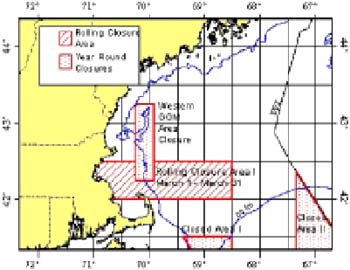
Rolling Closure Area II April 1 -
April 30 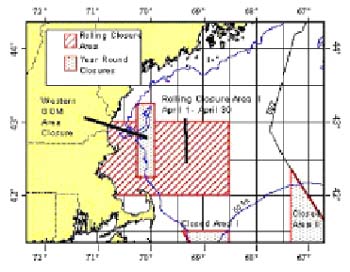
Rolling Closure Area III May 1 -
May 31 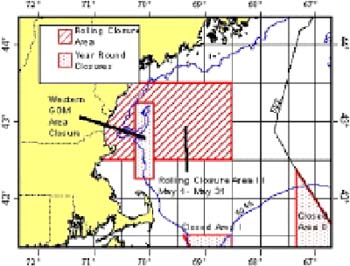
|
Slide 23
Slide 24
|
Forum Fisheries Agency
Key
characteristics
- Centralised service for 16 countries
- Application only to tuna vessels
- Directed at non-MS flag vessels
- Common protocols
- Inmarsat C only
- Harmonised VMS legislation
Developed over 15
years
- Ideas, legal framework
- Strong central administration
- Australian/NZ/EU technical and financial support
|
Slide 25
FFA & SPC areas
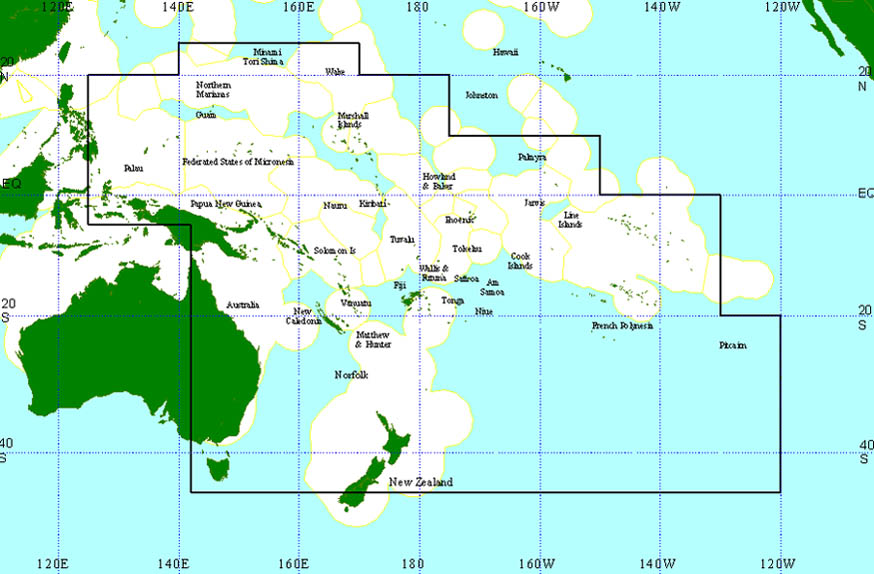
Slide 26
FFA - centrally coordinated
system
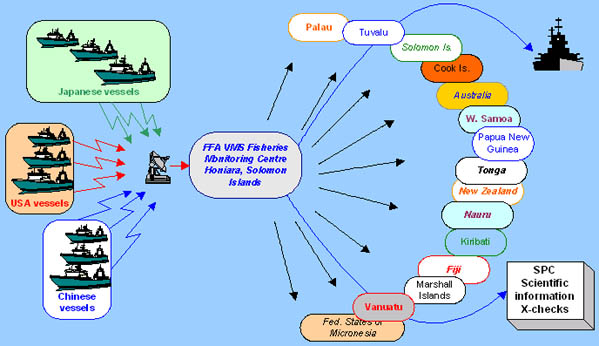
Slide 27
|
Common Fisheries Policy
Control
regulation
- Council Regulation (EC) N°686/97
amending Regulation (EEC) N°2847/93 establishing a control system
applicable to the common fisheries policy.
- Standards and protocols, e.g., Reg. 1449/98
entry/exit
Obligatory
- Member States can be penalised by
Commission/ECJ
Application
- vessels > 24m, > 12m
(proposed)
Third countries
RFOs
|
Slide 28
Slide 29
VMS in the EU
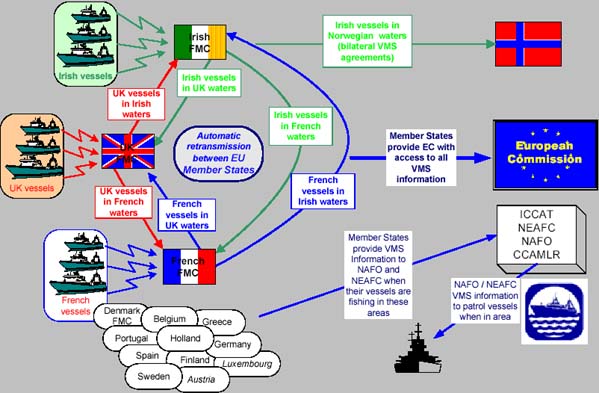
Slide 30
|
Scope and authority: FFA vs CFP
FFA
- FFA - South Pacific Economic Commission
- economic cooperation - FFA decisions, agreements, policy endorsed by SPEC
summit - Obligation: international agreement and peer
pressure
CFP
- EC Treaties - must apply EC legislation in full
- Enforcableby ECJ
- Member States can be penalised
|
Annex 5.6 Legal Issues Relating to VMS
Slide 1
|
Legal issues relating to VMS
by Henning OsnesTeigene
Workshop on VMS, Saly, Senegal, 14-17 October 2002
|
Slide 2
Slide 3
|
International law basis for the use of VMS
United Nations
Convention on the Law of the Sea (1982 UN Convention)
- in force from 16 November
1994
Agreement for the Conservation
and Management of Straddling Fish Stocks and Highly Migratory Fish Stocks (1995
UN Fish Socks Agreement)
- in force from 11 December
2001
Agreement to Promote
Compliance with International Conservation and Management Measures by Fishing
Vessels on the High Seas (1993 FAO Compliance Agreement)
- not in force
|
Slide 4
|
1982 UN Convention
Within the EEZ the
coastal state has sovereign rights to explore, exploit, conserve and manage the
natural resources (Article 56.1)
The coastal state shall ensure
through proper conservation and management measures the sustainable utilization
of the living resources of the EEZ (Article 61.2)
Nationals of other states
fishing in the EEZ shall comply with conservation measures, terms and conditions
established in coastal state legislation (Article 62.4)
Within the EEZ coastal states
may take such measures as may be necessary to ensure compliance with its laws
and regulations (Article 73.1)
States have responsibilities
over fishing vessels flying their flags (Article 117)
|
Slide 5
|
1995 UN Fish Socks Agreement
|
Slide 6
|
1993 FAO Compliance Agreement
Imposes flag state
responsibilities
- no state shall authorize its flag
vessels to fish on the high seas unless it is able to exercise effectively its
responsibility (Article III.3)
- States shall ensure that their flag vessels provide
information on their fishing activities, including on area of fishing operations
(Article III.7)
Requires states to exchange
information, including evidentiary material relating to activities of fishing
vessels (Article V.1)
|
Slide 7
Slide 8
|
The FFA solution
FFA VMS is
implemented under the auspices of the South Pacific Forum Fishing Agency
Convention
Harmonized Minimum Terms and
Conditions for Foreign Fishing Vessel Access include VMS requirements
Foreign fishing vessel must be
registered on the VMS register of Foreign Fishing Vessels
Each member State concludes
bilateral access agreements
- which must comply with the Harmonized
Minimum Terms and Conditions (among which are to “install and operate a
registered ALC on board the vessel; and maintain the ALC in good working
order”)
|
Slide 9
|
National legal basis
International
legal instruments not binding in areas under national jurisdiction and on
nationals
- Enabling national legislation is needed
to require the use of VMS
Other legal issues connected
to VMS (confidentiality, evidence, maritime boundaries) are primarily dealt with
under national law
|
Slide 10
|
National legal basis continued
- All the countries of the region have declared 200nm exclusive economic
zones
- All the countries have in place the legal framework for a licensing
system
- To varying degrees existing fisheries legislation provides the framework
for VMS regulations.
- Detailed regulations are lacking.
- Common law and Civil Law countries
- E.g. Sierra Leone 1994 Fisheries Decree Article 107 provides
wide powers to make regulations on “any other matter which
is required or authorised to be prescribed”.
- E.g. Morocco 1973 Sea Fisheries Act needed to be amended in order
to provide a legal basis for VMS
|
Slide 11
|
Constitutionality of VMS requirements
Legal implications
of all new approaches should be identified and analyzed
Countries have to ensure that
the introduction of the VMS system does not constitute a violation of the
supreme law of the country
To date VMS had not been
challenged in court on the ground so unconstitutionality
|
Slide 12
|
Confidentiality of VMS information Confidentiality of VMS
information is recognized to be a sensitive issue for the fishing
industry
Fisheries
administration’s responsibilities starts when information is received by
the monitoring agency, prior to this responsibility for security of data belongs
to the manufacturer
Countries need to determine
what kind of information would qualify as warranting confidentiality
- USA: all data required to be submitted
to the fisheries administration with respect to any fisheries management
plan
- Papua New Guinea: all data supplied by
VMS
|
Slide 13
|
Confidentiality continued Rules restricting disclosure
of VMS information can be found in different pieces of legislation
- Some countries include rules on
confidentiality and disclosure in fisheries legislation (to date not
common)
Legislation relating to
informational privacy and record keeping systems (in particular
computerized)
- Balance between government’s
legitimate need for information and the individuals right of informational
privacy
- Limits on the external disclosure of information a record
keeping entity may make
Legislation concerning
protection of commercially sensitive information
- Limitation on disclosure of information
that may lead to a commercial disadvantage
Confidentiality may be ensured
by the release of data in aggregated form
- Does not permit direct or indirect id
of natural or legal persons
|
Slide 14
|
Confidentiality continued Access to confidential
information
- Generally restricted to specified
categories of persons
- To safeguard confidentiality persons given access might be
held responsible for unauthorized disclosure
- Such persons must be informed and may be required to sign a
form of confidentiality (Norway)
Use of confidential
information
- As a general principle VMS information
shall only be used for fisheries management purposes (research (not USA),
enforcement)
- Secondary uses (based on enabling legislation) may
include:
- General
law enforcement (as evidence in court cases)
(Search and) rescue International
obligations
|
Slide 15
|
VMS as evidence Can VMS be used (by itself) as
evidence in judicial proceedings?
In common law countries VMS
information may be inadmissible in criminal proceedings due to the rule against
hearsay evidence
- (In short:) a testimony in court of a
statement made out of court resting for its value upon the out of court
statement
- Proof of physical location may be overcome by exceptions:
“rebuttablepresumption” and “judicial notice”
- Proof of activities (e.g. illegal fishing) at this stage
fails to furnish evidence of a sufficient caliber
Rules on admittance of
evidence in civil law countries are generally less strict than in common law
countries
|
Slide 16
|
VMS as evidence continued |
Slide 17
|
Maritime boundaries Certainty of boundaries of
maritime zones is required to ascertain the scope of application of VMS
requirements
Lack of clarity may destroy
any civil or criminal case
For the purpose of effective
VMS it is recommended that the countries ascertain their maritime boundaries and
conclude boundary agreements where necessary
|
Slide 18
|
Intellectual Property Question has been raised
whether the VMS database kept by the competent authority would be granted
copyright protection
- Might be questionable since
intellectual creativity as a distinctive human intervention is a basic
requirement
A pragmatic approach is to
leave the question of management of the information up to the coastal states as
the owners of the VMS information in respect of their EEZ
|
Slide 19
|
Main features of VMS regulations |
Slide 20
Slide 21
Slide 22
Slide 23
|
Closing Remarks Most of the countries of the
sub region should be able to support implementation of VMS through their
licensing systems
- But, this is a short term
measure
The adoption of new
legislation or amendments to existing legislation are better options as they are
able to deal with some of the legal issues discussed in the
presentation
- Drawing on experience from the FFA
regional VMS cooperation countries who incorporated the provisions recommended
by FFA into national legislation have had more success in ensuring that vessels
install and keep operational at all times their ALCs
|
Annex 5.7 Putting VMS Into Practice: The Devil is in the
Details
Slide 1
|
Putting VMS into practice The devil is in the details
Robert Gallagher
FAO Consultant
|
Slide 2
|
Planning is the key to success
-
Four stage process
- Feasibility study
- Means available, technical, human, economic?
- Definition stage
- Functional specification developed, tender documents finalized
- Selection stage
- Supplier chosen, delivery schedule decided
- Delivery stage
- System implemented and exhaustively tested
|
Slide 3
|
A series of critical choices
Transmission
medium ship-to-shore Terrestrial transmission
medium Characteristics of FMC and
“clients” Supplier for FMC Future-proofing the
system
|
Slide 4
|
Ship to shore transmission issues
What is my
required geographical coverage? How timely is the required
data? What power supply is available
aboard vessels? What supplementary services
are necessary?
|
Slide 5
|
Ship-to-shore available choices
ARGOS Emsat/Euteltracs Inmarsat-C Inmarsat-D+ Terrestrial systems Voice
systems
|
Slide 6
|
ARGOS Advantages
- World-wide coverage
- Simple and reliable
- Relatively low power consumption
Disadvantages
- Delays in delivery of data
- One-way communications only
|
Slide 7
|
Emsat/Euteltracs Advantages
- Quasi real-time data
- Voice services for vessel crew
Disadvantages
- Limits to geographical cover
- Relatively expensive equipment
- Requires sturdy power supply
|
Slide 8
|
Inmarsat-C Advantages
- Quasi real-time data
- Small and light equipment
- Multiple manufacturers
- GMDSS
- Data messaging
Disadvantages
- Equipment relatively expensive
- No coverage in polar regions
- Requires sturdy power supply
|
Slide 9
Slide 10
|
Terrestrial systems (VHF/cellular)
|
Slide 11
|
Voice systems (satellite, i.e. Iridium,
Globalstar)
Provides voice for
vessel crew Iridium coverage quasi
wold-wide Not best adapted for data
transmission Globalstar coverage marginal
in ocean regions Will they be here
tomorrow?
|
Slide 12

Slide 13
|
Terrestrial transmission: getting the data to the
FMC |
Slide 14
|
If answer to these three question is
negative Living with low-quality voice
lines
- Problems of economy
- Operational difficulties
Fixed satellite services, e.g.
V-SAT
- Implies high data throughput
Mobile satellite services
could be the answer
Each case studied
individually
|
Slide 15
Slide 16
|
Don’t’ forget the future
Will your use of
the data develop over the next few years? Will your department expand in
the next five years? Will demands on your data
increase from other national services? Is a regional VMS or MCS on
the horizon?
|
Slide 17
|
Time spent planning and understanding the requirements of
users is ALWAYS time well-spent |
Annex 5.8 Towards a Subregional VMS Strategy
Slide 1
|
Towards a subregional VMS strategy
prepared by
Kieran Kelleher
Sub-Regional Fisheries Commission
FAO Joint VMS Workshop
Saly 14-17 October 2002
|
Slide 2
|
Presentation
1. Identify possible objectives and
targets
2. Develop sub-regional scenarios:
3. Assess the Sub-Regional context using
- SWOT analysis (points
forts/faiblesses/opportunites/menaces ourisks)
4. Conclusions
|
Slide 3
|
Possible generic objective(s)
|
Slide 4
|
Target fleets? SRFC Member State flag
industial vessels
- ‘National’ industrial vessels
(i.e., operating only in flag state) - Selected fisheries, or groups of vessels - ‘Sub-Regional’ industial vessels (i.e., operating
in more than 1 Member State)
Foreign (i.e., non-Member
State flag) vessels
- joint position vis a
vis
Large/‘migrating’
artisanal vessels
Reefers and supply vessels
(bunker) 82 vessels
|
Slide 5
Slide 6
|
FFA ® SRFC a shared
subregional model |
Slide 7
FFA model ® SRFC
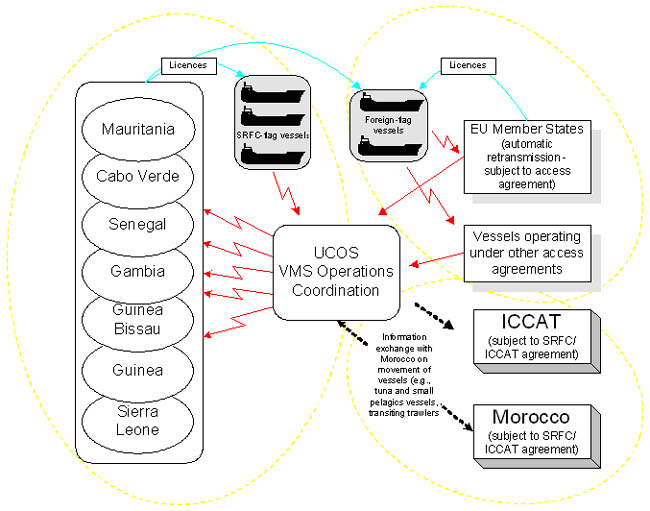
Slide 8
Representation of the FFA model -
UCOS decision engine, client server network
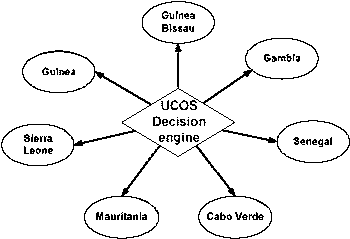
Slide 9
|
FFA model: advantages and disadvantages Advantages
- Lower costs, effective coordination (in
principle)
Disadvantages
- Institutional weakness of SRFC/UCOS
- Timely payments problem?
- Not an integral part of the national security system
Questions
- not necessary for all vessels, e.g. if a vessel only fishes in
Sénégal
- ? how to select target groups of vessels
|
Slide 10
|
CFP model ®
SRFC All SRFC states operate their
own VMS Agree to provide information
to each other
- ? which fleets are the targets of VMS cooperation
- ? type of information to be exchanged
SRFC VMS Convention and
permanent working group Standardise data exchange (and
equipment?) Mutual assistance and
technology transfer Gradual development of VMS
network Presence of equipent service
agents throughout subregion
|
Slide 11
Information exchange in a peer to
peer configuration Secure Network WAN
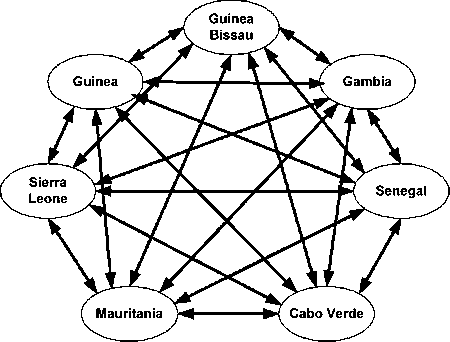
Slide 12
Peer to peer model network (EU)
(simplified representation)

Each Member State operates a decision engine,
information exchange is under agreement(s) with other Member States
Slide 13
CFP model cooperating national
systems
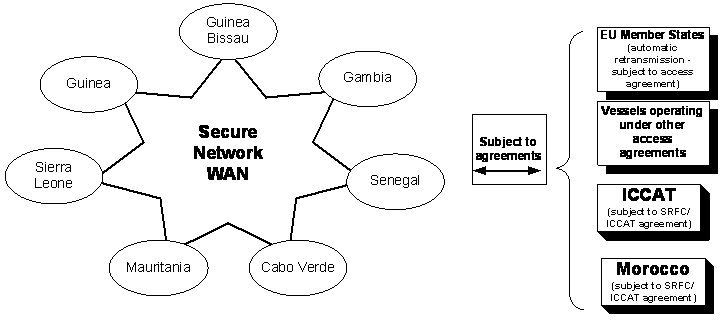
Slide 14
|
CFP model - advantages and disadvantages Advantages
- Full national responisbility and
control
Disadvantages
- Higher costs
- Un-necessary duplication of equipment
- Possible compatibility/data exchange problems
- Weakened common approach to foreign vessels
|
Slide 15
|
Fishery specific: example: Senegambia shrimp trawl
fishery |
Slide 16
|
Bilateral service arrangement Example:
Sénégal/Gambia
Example:
Sénégal operates a VMS system on behalf of Gambia for all
industrial vessels licensed to fish in Gambia
(near) Real-time access by
Gambia authorities for Gambian all Gambian vessels
Automatic transmission to
Gambia of VMS data on Senegalese vessels transiting Gambia, or fishing in
Gambian waters
Possible extension to cover
other countries/areas, e.g., Agéncia de Cooperação
GB/Sénégal
Eventual network of such
agreements
Possibloe service contract
with reputable commercial operator to guarantee effective
operation
|
Slide 17
|
SWOT analysis
Internal to SRFC and Member States
External
|
Slide 18
|
Strengths
Unifying character
of SRFC Existence of UCOS and joint
MCS programme MCS conventions and bilateral
protocols IUU declaration and SRFC
‘strategic action plan’ VMS operating in
Sénégal and Mauritania already considering, Guinea
testing SRFC vessel register
initiatives Joint research capability
(SIAP) established
|
Slide 19
Slide 20
|
Opportunities FAO strategy on IUU and
VMS
- FISHCODE, COFI
- ICCAT
EU access agreements already
include provisions for VMS
Maritime security a global
concern
- drugs, terrorism, illegal immigration
- safety, oil pollution
Financial and cost related
opportunities
- EU, commercial banks, vessel operators
- Possible future cost reductions
- Combined action - local land station (s)
- operating costs jointly negotiated
|
Slide 21
|
Threats
Vendors selling
proprietary (closed) VMS systems Suppliers poorly represented
in subregion Opposition by vessel
operators Possible failure of supplier
companies
|
Slide 22
|
Conclusions Cooperation essential not
merely desirable
- Evident from the national and regional
examples
No recommendations .... your
work
Actions you may wish to
consider:
- Draft sub-regional strategy
- Working group to follow up
- More detailed study of the options
- Pilot schemes - communicate results
- Identify possible donors
- ? a model VMS regulation
- Feasability studies
|

































